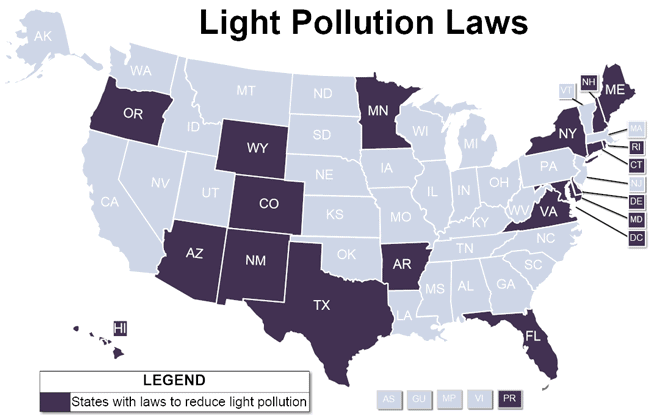Although the topic of light pollution and legislation are not typically glamorous topics, nor are they fun topics to discuss, light pollution legislation might be a way to reduce light pollution in a long term and sustainable fashion.
Implementing laws to limit the growth of and restrict current light pollution is one that is very tricky as there are a plethora of options that are available. There are benefits to implementing light pollution prevention such as environmental, economical, and health reasons. It isn’t natural for animals who have evolved with only moonlight to have to navigate with the interference of light pollution. Moreover, it is said that a large percent of light is wasted by not shielding the light as light shields often mean fewer watts are needed to light the same area. This would save the government and entities money in the long term by having to reducing electricity bills. Moreover, by implementing light pollution restrictions such as shielding, jobs could be created and economies stimulated to meet the demand for providing and installing the light shields. The health reasons for light pollution standards is that light pollution isn’t great for human health and has been linked to things such as cancer.
The best way to get started is to talk with the mayor and legislators for your town and go from there. Come prepared with the benefits of addressing light pollution, how your proposal will address the solution, and the benefits of the solution for your city. After starting locally, start networking as there is a great benefit to networking as greater numbers mean more influence and exposure to the topic. The IDA has some great tips and recommendations for how to handle this meeting, but starting locally before moving to a greater scope will assist in providing some momentum and benefits. The benefits of starting locally is that even if the state does not adopt light pollution measures, at the very least, you will have made a positive impact upon your local jurisdiction that is a step in the right direction. Other jurisdictions might follow the lead that you set by having your jurisdiction handle light pollution.
There are several organizations that have already taken the step to help write laws, building codes, and other legislation on light pollution. The International Dark Sky Association has some great links that provide this information. A great template for writing new legislation is to review legislation passed by other states, see which have been most efficient, and determining how that type of legislation can be effective in your jurisdiction. With the goal of reducing light pollution, there are many ways that one can write to help reduce light pollution, which include but are not limited to building code changes, laws restricting new building structures, laws limiting runtime, and laws limiting the glare of the bulbs. For the best guidelines for limiting light pollution, check the Illuminating Engineering Society (IES) guidelines as a great starting point as well as prior legislation.
There are several ways to get these types of statutes and laws passed, the method of which depends on what options are available. The most straightforward way to get this law passed would be to have the legislature of said state, city, or country vote to enact these laws. However, this might not always be the best option as light pollution legislation might not be at the top of the list of items to propose or vote upon. If the legislature is the only option, then a campaign of contacting representatives will be the most effective option. Nevertheless, there are some US States that have ballot initiatives that allow citizens to pass new light pollution laws and statutes without legislative approval. 24 US states and Washington DC have some form of citizen referendum, which means that if the requirements are met for a proposal to be on the ballot, then the public will be able to vote on the issue. These referendum requirements vary per state, but often include the ability to collect enough signatures from valid voters in the state to make it onto the ballot.
In a 2016 examination by the National Conference of State Legislatures, they found that “At least 18 states, the District of Columbia and Puerto Rico have laws in place to reduce light pollution. The majority of states that have enacted so-called “dark skies” legislation have done so to promote energy conservation, public safety, aesthetic interests and astronomical research capabilities. Municipalities in a number of states have also been active on this issue, adopting light pollution regulations as part of their zoning codes.[1]” These states have all seen benefits from these laws, although the benefit has varied as the laws have different verbiage and goals. For example, Texas has placed restrictions for certain lighting surrounding military installations under some circumstances. Moreover, Arizona has some of the most aggressive laws due to their status as a worldwide hub for astronomy.
References And Further Reading
[1] = https://www.ncsl.org/research/environment-and-natural-resources/states-shut-out-light-pollution.aspx
Introduction To Light Pollution
https://ballotpedia.org/States_with_initiative_or_referendum

Be the first to comment on "Light Pollution Legislation"